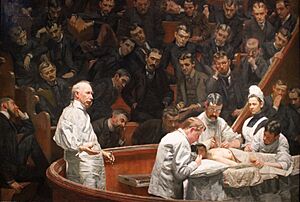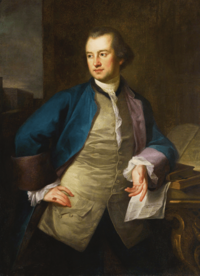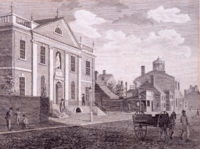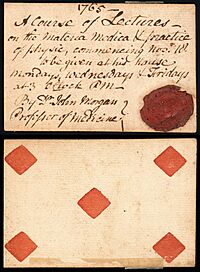Perelman School of Medicine facts for kids
 |
|
|
Other name
|
Penn Med |
|---|---|
| Type | Medical school |
| Established | 1765 |
|
Parent institution
|
University of Pennsylvania |
| Affiliation | University of Pennsylvania Health System |
| Dean | Jonathan A. Epstein (interim) |
|
Academic staff
|
2,100 (full-time) 1,200 (residents and fellows) |
|
Administrative staff
|
3,334 |
| Students | 775 M.D. students 594 Ph.D. students 186 M.D.-Ph.D. students 329 masters students 704 post-doctoral fellows |
| Location |
,
,
U.S.
39°56′52″N 75°11′33″W / 39.94778°N 75.19250°W |
| Campus | Urban |
The Perelman School of Medicine, also called Penn Med, is the medical school at the University of Pennsylvania. This is a private university in Philadelphia. It is part of the Ivy League, a group of famous universities. Founded in 1765, it is the oldest medical school in the United States. Today, Penn Med is a big center for medical research and teaching. It has over 2,900 teachers and researchers. They also get almost $1 billion each year for their research projects.
Contents
Discovering the History of Penn Med
How it All Began: The 1700s
The idea for a medical school came from John Morgan. He was a graduate of the College of Philadelphia. He also studied at the University of Edinburgh Medical School in Scotland. After his training, Morgan returned to Philadelphia in 1765.
He and William Shippen Jr., who also studied in Edinburgh, convinced the college to start a medical school. This became the first medical school in the original Thirteen Colonies. Before the school opened, Morgan gave a speech. He hoped the new school would be a great example for others. He wanted it to spread knowledge across America.
In the fall of 1765, students began taking classes. They learned about anatomy and how to treat illnesses. The school was like the University of Edinburgh Medical School. Students learned in lectures and by helping patients at the Pennsylvania Hospital.
Early teachers at the school were famous doctors and scientists. These included Benjamin Rush and William Shippen Jr.. Dr. Benjamin Rush was also a Founding Father. He signed the United States Declaration of Independence.
Growth in the 1800s

In the mid-1800s, important teachers included William Pepper and Joseph Leidy. Nathaniel Chapman was also a faculty member. He helped start the American Medical Association. Later, two doctors who helped found Johns Hopkins Hospital in Baltimore, William Osler and Howard Atwood Kelly, came from Penn's medical faculty.
The 1900s and Beyond
In 1910, a report called the Flexner Report looked at medical education. Penn was one of the few schools that had high standards. This included how students were accepted and how they were taught.
In 2011, the school got a huge gift of $225 million. This gift was from Raymond and Ruth Perelman. Because of this, the school was renamed the Perelman School of Medicine. This was the largest gift ever given to the university at that time.
Where Penn Med is Located
From 1765 to 1801, medical classes were held in Surgeon's Hall. This was in Center City Philadelphia. In 1801, the medical school moved with the rest of the university.
In the 1870s, the university moved again. It went across the Schuylkill River to West Philadelphia. The medical teachers wanted a teaching hospital right next to the new school buildings. So, Penn's medical school and its main hospital are now very close. They are part of the main university campus. The Children's Hospital of Philadelphia and the Wistar Institute are also nearby.
The main hospitals where students learn are:
- Hospital of the University of Pennsylvania
- Penn Presbyterian Medical Center
- Pennsylvania Hospital
- Children's Hospital of Philadelphia
Students also learn at other hospitals. These include Chester County Hospital and the Philadelphia VA Medical Center.
Amazing Medical Discoveries
In the late 1800s and early 1900s, Penn Med helped new medical fields grow. These included brain surgery (neurosurgery) and eye care (ophthalmology). They also advanced skin care (dermatology) and X-ray imaging (radiology).
Between 1910 and 1939, Alfred Newton Richards was a key leader. He helped Penn become a top place for medical science. This helped the U.S. catch up with European medicine.
In the 1950s and early 1960s, Jonathan Rhoads mentored Stanley Dudrick. Dudrick found a way to feed patients who could not eat normally. This method is called total parenteral nutrition (TPN).
In the 1980s and 1990s, C. William Schwab made big steps in trauma surgery. He developed "damage control surgery." This helps very badly injured patients.
In the 1990s and 2000s, Paul Offit helped create the modern RotaTeq vaccine. This vaccine protects children from a serious stomach illness.
In 2006, Dr. Kaplan and Shore found the cause of a very rare bone disease. It is called fibrodysplasia ossificans progressiva.
How Doctors Learn: The Curriculum
Medical science and practice are always changing. So, the school often updates how it teaches. Big changes happened in 1968, 1970, 1981, 1987, and 1997.
The most recent major change was in 2022. They started the IMPaCT curriculum. This new way of teaching focuses on learning in small groups. It also encourages students to learn on their own. The curriculum has three main themes:
- Science of Medicine
- Technology and Practice of Medicine
- Professionalism and Humanism
These themes were created by groups of teachers and students.
Learning About Medical Research
Biomedical Graduate Studies (BGS) is part of the Perelman School of Medicine. It started in 1985. About 700 students study here to get a PhD in basic medical sciences.
BGS has over 600 teachers from different Penn schools. It also works with places like the Children's Hospital of Philadelphia. There are seven main study areas, called "graduate groups," for a PhD. These include:
- Biochemistry and molecular biophysics
- Cell and molecular biology
- Epidemiology and biostatistics
- Genomics and computational biology
- Immunology
- Neuroscience
- Pharmacology
All students in these programs get money to help with living costs. They also get a full scholarship. Most students finish their degree in about 5.4 years. Students can also get extra certificates in public health or environmental health. Each study group has its own rules and courses.
Famous People from Penn Med
Many important people have studied or taught at Penn Med. Four of them won the Nobel Prize. Two alumni also received the Medal of Honor.
See also
 In Spanish: Escuela de Medicina Perelman para niños
In Spanish: Escuela de Medicina Perelman para niños
- Guatemala Health Initiative
- List of Ivy League medical schools
- Medical schools in Pennsylvania
- University of Edinburgh Medical School
- University of Pennsylvania Health System






